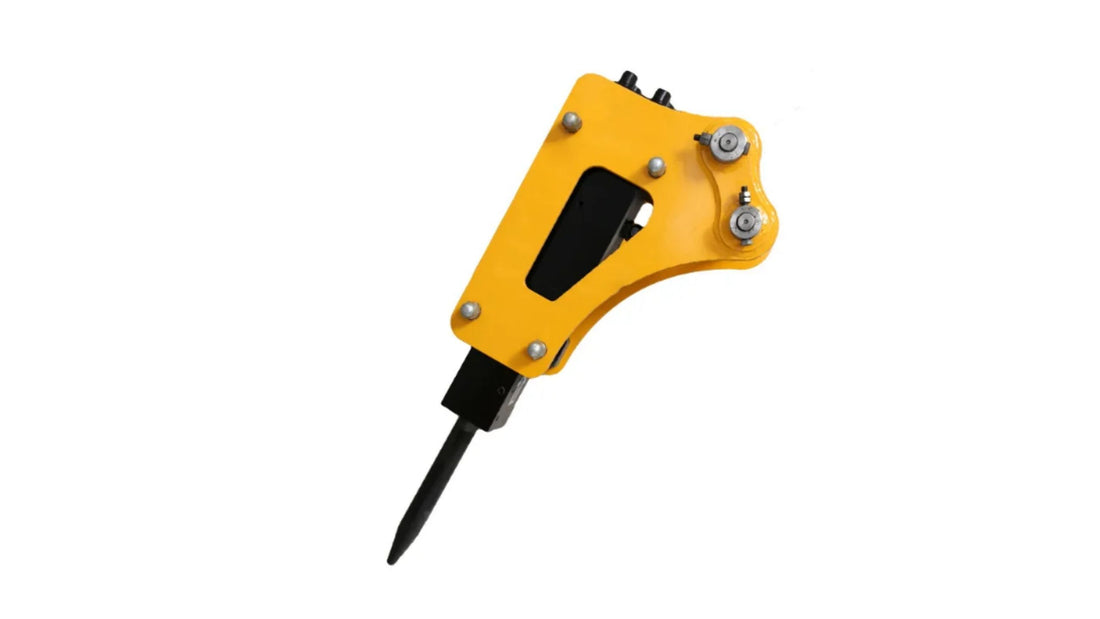Introduction to Hydraulic Breakers
A hydraulic breaker is an attachment that can be attached to a mini excavator and uses the power of hydraulics to generate force to break tough materials such as concrete, asphalt, and rock. Hydraulic breakers are a valuable tool for construction and demolition projects, as they allow you simplify the process of breaking through hard surfaces. They are also used in mining, quarrying, and other industries that require the breaking of tough materials.
Hydraulic breakers are available in a variety of sizes and models, and can be tailored to fit your specific needs. The size and type of hydraulic breaker you choose will depend on the type of job you are doing, as well as the size of your mini excavator.
Benefits of a Hydraulic Breaker
The primary benefit of a mini excavator hydraulic breaker is the increased power and efficiency it provides. With the additional force generated by a mini excavator hydraulic breaker, you can break through tough materials in a fraction of the time it would take without one. Additionally, the force generated by a hydraulic breaker is much more precise than that of a manual hammer, meaning you can break through materials without causing unnecessary damage.
Mini excavator hydraulic breakers are also much safer to use than manual hammers. With a manual hammer, it’s easy to cause accidental damage to nearby structures.
How a Hydraulic Breaker Works
A hydraulic breaker works by using the power of hydraulics to generate force. Three main parts of the mini excavator hydraulic breaker hammer are: back head (nitrogen chamber), cylinder assembly, and front head.
- Back Head: contains the nitrogen chamber that under pressure acts as a cushion to absorb force from the chisel during the return movement. During the forward movement the nitrogen chamber increases impact force.
- Cylinder Assembly: contains control valve, piston and the cylinder itself. The control valve is responsible for the reversal of the hydraulic fluid direction that enables "back and forth" piston movement.
- Front Head: allows connection of the chisel with the piston. The chisel is secured in the front head with the help of a tool retaining pin
Types of Chisels for the Mini Excavator Hydraulic Breaker
There are many different types of the mini excavator hydraulic breaker chisel shapes, but the most common are:
- Blunt chisel: Designed for medium to light demolition, and jobs where crushing action is required. Commonly used for crushing rocks.
- Flat chisel: A common and versatile chisel used for separating action and other general applications, such as excavation and demolition. Commonly used for concrete and asphalt breaking
- Moil chisel: Designed for medium to heavy demolition, such as breaking up reinforced concrete and asphalt. It is also used for removing concrete, rebar, and other objects from horizontal surfaces.
- Conical chisel: Used for heavy demolition, thick concrete and large rock breaking.

Mini Excavator Hydraulic Breaker Maintenance
As any equipment, mini excavator hydraulic breakers require regular maintenance to prolong their service life. Basic maintenance includes:
- Regular greasing: It is recommended to grease mini excavator hydraulic breaker parts every two hours of operations. Yes, this means that if you have a demolition project, your mini excavator hydraulic breaker will need to be greased several times a day. Irregular greasing will significantly reduce it's service life.
- Nitrogen Check: it is recommended to conduct nitrogen pressure checks on a weekly basis. It should be noted that nitrogen pressure is impacted by temperature. It is highly recommended to conduct these checks if you experience a significant temperature change between jobs.
- Proper storage: It is recommended to store mini excavator hydraulic breakers vertically to prevent excess uneven pressure on the seals. If the mini excavator breaker is being stored for an extended period of time, then antirust grease should be used to protect breaker's parts from corrosion.
Best Practices when Operating a Mini Excavator Hydraulic Breaker
Mini Excavator Breakers generate large amounts of force and improper use of the breaker can damage the breaker itself. To ensure that the mini excavator breaker will last as long as possible, it is recommended to keep in mind these best practices:
- Position the chisel at a 90 degree angle to the surface.
- Regularly reposition the chisel to prevent overheating
- Move the chisel in small steps
- Regularly ease and slightly lift the chisel to allow dust to escape from between chisel tip and the surface
- Never hit the same spot for longer than 15 seconds at a time
- Do not use the mini excavator hydraulic breaker as a crowbar or to move rocks (there's better tools for those jobs)
- Avoid dryfiring of the mini excavator hydraulic breaker
- Be aware of flying debris. Make sure arm cylinder has a cylinder shield installed and always wear personal protection when operating
- Never fully submerge the mini excavator hydraulic breaker into water or any other liquid
To Summarize
A hydraulic breaker can be a valuable addition to your mini excavator, as it can help you break through tough materials quickly and efficiently. With the additional power of a hydraulic breaker, you can complete your projects in a fraction of the time it would take without one. Additionally, you can use a hydraulic breaker to break through materials without causing unnecessary damage to nearby structures.
When using a hydraulic breaker, it’s important to keep safety and maintenance in mind. Before using the breaker, make sure to read the manual and familiarize yourself with the operation and maintenance procedures. Additionally, make sure that you are wearing the proper PPE, such as safety glasses and ear protection.
If you are interested in purchasing a hydraulic breaker for your mini excavator, contact us today to learn more about our selection of high-quality hydraulic breakers.
Click here to visit Home Page


















